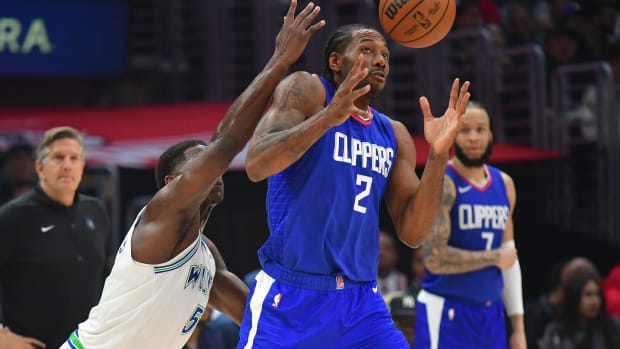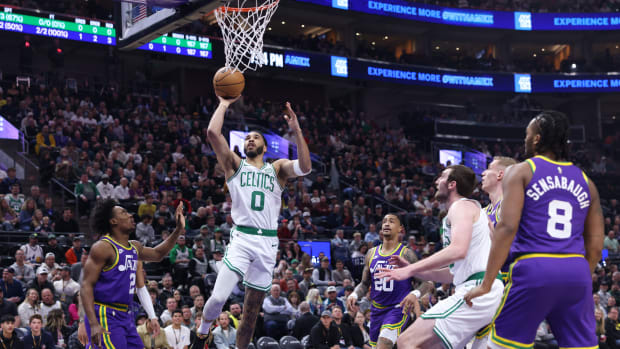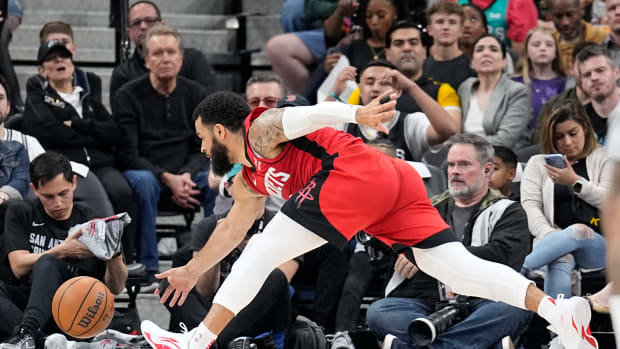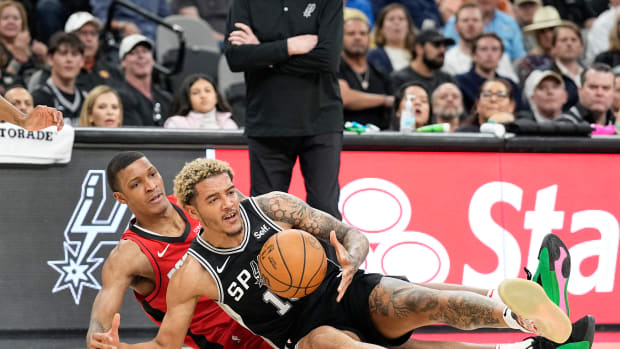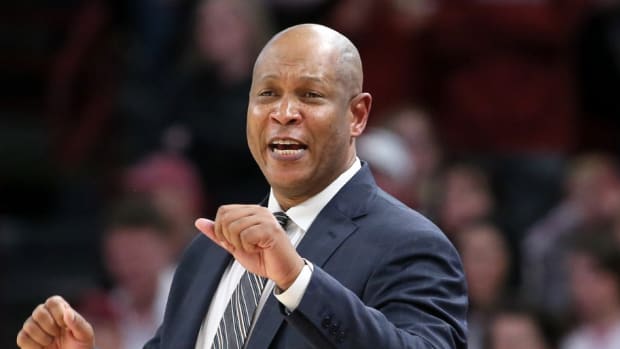What Nikola Jokić's MVP Win Means for the Big Man
Welcome to the Morning Shootaround, where every weekday you’ll get a fresh, topical column from one of SI.com’s NBA writers: Howard Beck on Mondays, Chris Mannix on Tuesdays, Michael Pina on Wednesdays, Chris Herring on Thursdays and Rohan Nadkarni on Fridays.
Nikola Jokić was named the NBA’s MVP last week and, perhaps outside of the Jokić clan, no single individual was happier than Shaquille O’Neal.
“First thing, thank you,” O’Neal told Jokić, the 26-year-old Nuggets star, during a video call on TNT’s Inside the NBA. “Because of you, the big man is back. You’re the first big man to win a MVP in a long time. I thank you, and I appreciate you very much.”
Jokić smiled that sheepish smile of his and poked his finger toward the camera a few times—as if to say, Appreciate you, too, Big Fella.
It had been 21 years since a true, full-time center won MVP, 21 years since O’Neal himself cradled the Maurice Podoloff Trophy with his big-man hands and made big-man proclamations about big-man dominance and big-man goals.
Then the NBA got small. The game got fast. The guards and wings took over and started flinging threes by the dozen. Even the 7-footers started doing it—and though the yardstick said they were still big, they started playing small, drifting farther from the painted area—and this saddened and infuriated the giants of yesteryear.
“Nobody’s playing like a center full time,” O’Neal groused in 2019.
Shaq wanted the bigs to bruise and bulldoze and intimidate and rule the paint, the way he did while leading the Lakers to three championships in the early 2000s. The way his generational rivals, Hakeem Olajuwon and Patrick Ewing and David Robinson, did. The way his forebears, Kareem Abdul-Jabbar and Wilt Chamberlain and Bill Russell, did.
But the rules changed, the game evolved and the big men seemed to shrink—if not in size, then in significance. Oh, they still grabbed lots of rebounds and blocked some shots and set screens, but none could drop 35 points while destroying rims and your self-esteem. They certainly couldn’t be an MVP.
For a time, it appeared the term “franchise center” would be consigned to the dustbin of NBA obsolescence, alongside the two-handed set shot, John Stockton’s short-shorts and Kareem’s skyhook.
Jamaal Magloire, a man of limited ability but enviable height, made the Eastern Conference All-Star team at center in 2004, for lack of anyone more compelling. Chris Kaman, who is mostly renowned for taking a midgame nap across five chairs, became an All-Star in 2010—the least bad option at a position that looked ever more irrelevant.
Two years later, the NBA removed “center” from the All-Star ballot entirely, replacing it with the generic “frontcourt”—a concession to changing norms, sure, but also a subtle admission that league officials found “Chris Kaman, All-Star” just as icky as the rest of us did.
Dwight Howard repped the position respectfully for a while, even powering the Magic to the 2009 Finals, with a fearsome blend of power and dexterity. But Howard was mostly a defensive maestro and at-the-basket finisher—not a dominant low-post scorer in the tradition of Shaq and Hakeem and Kareem. (And, notably, that Magic team—which lost to Kobe Bryant’s Lakers—was the last Finals team built around a star center.)
During his prime, Howard was a staple of MVP ballots, appearing every year from 2008 to '12, and as high as second in '11. But as he faded, so too did the center in MVP discussions. From '12 to '18, the highest finish by a center was fourth, by Bulls defensive ace Joakim Noah in '14.
In 2012, The Atlantic devoted 2,500 words to “The Mystery of the Disappearing NBA Center,” noting, “In a game fundamentally built on height, it seems the tallest player is being phased out.” It was the latest in a series of anguished think pieces fretting over the big man’s demise—at least as a franchise-defining star.
“Who do kids emulate?” Hall of Famer Jerry West asked in the Atlantic piece, before answering his own question. “They don’t emulate big players. They emulate smaller people who can dribble the ball through a damn Coke bottle. Those are the things that excite kids.”
If there was a premonition of where the game was headed, it came in 2007, when Dirk Nowitzki, a 7-footer from Germany, won MVP—but as a sweet-shooting power forward.
If there was a clear nadir for the NBA center, it came in 2016. That spring, not a single true center made an MVP ballot, not even a token fifth-place vote. It happened again in '17—the only two years in NBA history that zero centers appeared in the balloting. Two very tall players did earn votes in '17, but Anthony Davis (6' 10") and Giannis Antetokounmpo (6' 11") do not play like traditional centers, nor want that positional designation.
Centers claimed nearly every regular-season MVP award from 1958 (Bill Russell) through '83 (Moses Malone)—including 16 years straight, from '65 to '80. Even in the years they didn’t win, centers heavily populated MVP ballots throughout the '80s and '90s, peaking in '93–94, when four of the top five vote-getters were centers (Olajuwon, Robinson, O’Neal and Ewing). That quartet—the Four Horsemen of the Coming Center Apocalypse—repeated the feat in '95.
In February of that same year, in Sombor, Serbia, Nikola Jokić was born, the third of three boys. He grew to love horses and basketball, eventually becoming good enough at the latter to become the 41st pick of the 2014 NBA draft.
Tim Connelly, presiding over his second draft as Nuggets GM, did not set out to draft a franchise center, and certainly didn’t expect one in the second round. Though he did also acquire Jusuf Nurkić, the 16th pick, from Chicago, hoping one giant or the other might prove useful.
“We weren't position-specific,” Connelly says now. “I think our biggest goal from the onset of taking the job is finding a top 20 player, kind of hell or high water … positions be damned.”
That Jokić became that guy is a story unto itself, Connelly notes, of “a ho-hum, 13-year-old point guard with no real aspirations and no thought he could play at any serious level of basketball,” who grew to a beefy 6' 11" and brought all his point-guard skills with him, while also becoming a beast in the low post.
In the NBA, traditional centers had been undermined by two rule changes in the early 2000s: the prohibition of hand-checking on the perimeter (thus allowing smaller, quicker players to thrive); and the introduction of zone defense (making it easier to double-team players near the basket). In the short term it meant life got tougher for the big men who thrived in the paint—thus, the handwringing and periodic eulogies over the last two decades. But it also, eventually, nudged coaches at every level to start teaching guard skills—shooting, ballhandling, passing—to players of every size and shape, something that was already happening in Europe and elsewhere.
It just took a while for the new generation of more skilled, more well-rounded bigs to arrive. Now there are several, though many of them—Davis, Karl-Anthony Towns, Bam Adebayo, Domantas Sabonis, Kristaps Porziņģis—prefer playing power forward to center, and shooting jumpers to banging inside. Nor do they all have the prowess or will to dominate that it takes to become an MVP.
But there are at least two now who proudly wear the center’s mantle and have the swagger and skill to power a contender: Jokić and the 76ers’ Joel Embiid, who finished second in the MVP race. They’re the first centers to finish 1st and 2nd since 1995 (Robinson and O’Neal). And, notably, both learned the game in other parts of the world—Jokić in Europe, Embiid in Cameroon.
Today’s NBA “rewards skill, to a higher level than say size and strength,” says Pelicans coach Stan Van Gundy. “And so what you've got in Jokić and Embiid are two highly skilled guys. Regardless of position, skill will never go out of vogue.”
Their games are fundamentally different, but Jokić and Embiid have some important traits in common. Both can shoot from outside, put the ball on the floor, and drive and bully defenders in the paint when the opportunity is there. They are perfectly attuned to the modern game, blending both power and skill.
“Those guys developed skills that maybe 10 years ago weren't even taught to centers,” Connelly says. “Ballhandling, being able to step away from the basket, playmaking, instead of just hey, run block to block, dunk, block, rebound, half-hook left shoulder, half-hook right shoulder. You’re seeing the grander scale of how the league and the game has developed, where skill is king. I think those guys developed as skilled basketball players first, as opposed to just traditional [centers].”
Perhaps we’ve reached a turning point, if not yet a full renaissance. Jokić is in his sixth season. Embiid is 27, firmly in his prime. Both are anchoring elite teams and should be fixtures in the MVP race for years to come.
More significantly, they’ve established a new template for young bigs, of what a modern-day center should be: skilled, versatile, mobile, capable of scoring from anywhere like a guard, while still defending the paint like their predecessors.
“The 12-year-old [fan] won't remember, other than seeing Shaq on TV, they won't remember his game,” says Nets assistant coach Mike D’Antoni. “When you are a kid, you dream about being a certain player or playing a certain way. Well, in their mind, they're gonna see Embiid, and they're gonna see Jokić. They're gonna see a lot of guys that play on the perimeter, or have that ability at least. I think it's natural that the new generation of centers—the majority, not all—will have those skills.”
In the meantime, the NBA has been gifted a wide range of highly effective—if not necessarily scoring-dominant—centers, from defensive extraordinaires like Rudy Gobert to pick-and-roll maestros like Clint Capela and Montrezl Harrell to shot-blockers like Jarrett Allen and Mitchell Robinson. It’s not the second coming of Ewing, Olajuwon and O’Neal, but it’s not the wasteland of Magloire and Kaman, either.
The NBA center has been declared dead more often than newspapers, rock music and stand-up comedy. Indeed, this very magazine eulogized the center as far back as February 1988, in a cover story by Jack McCallum titled, “WHERE ARE THEY? The Once Dominant NBA Center Has All But Disappeared.” At the time, Abdul-Jabbar was 40, Moses Malone and Robert Parish were in their 30s, and Ewing and Olajuwon were young stars just beginning to make their mark—and with few identifiable peers.
“Will centers become as faceless as offensive tackles?” McCallum wondered aloud. As it happened, a golden age for centers was just around the corner—and one of the most dominant ever would be ripping down NBA backboards a short time later. Shaq kept the position relevant, and the positional obituaries at bay, for the better part of two decades, until his retirement in 2011, when the panic began anew.
But the center never did die. It just sort of hibernated for a while, took a little time to reflect and evolve and recalibrate, until the time was right to dominate once more. Today’s MVP center might not look or play exactly like Shaq did, but it’s close enough to make the big fella smile again.
More NBA Playoffs Coverage:
• Suns Sweep Nuggets Behind CP3's Big Night
• Durant and the Nets Falter Without Harden and Irving
• The Clippers Are Battling the Jazz—and Their Own Cursed History































